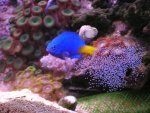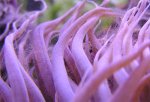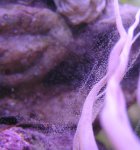Pa evidentno je da su Damsel-i polozili jajasca i nista vise. Da bi se izlegle ribice trba da im se obezbede posebni uslovi a to nikako nemoze u jednom akvarijumu kakav je Jasenkin ili bilo cij drugi koji nam sluzi u druge svrhe.
Da sada nepisem na siroko i na dugacko a ionako bi pisao o necemu sto licno nisam nikada radio pa zato cu da postavim jedan mali tekst koji govori bas o tim damsel-ima kakav je Jasenkin.
Olivotto, I, Cardinali, M., Barbaresi, L., Maradonna, F. and O. Carnevali. 2003. Coral reef fish breeding: the secrets of each species. Aquaculture 224(1-4):69-78.
I must confess, when I first came across this paper, I thought I had hit the holy grail of ornamental fish aquaculture! However, that excitement quickly dissipated like a pack of killer rabbits on a Holy Knight trail when I read the paper. The paper describes the first successful rearing of the yellow tail damselfish, Chrysiptera parasema. I am not sure how this relates to the secrets of each species, since they only bred the one species, but fear not, read on.
The researchers set up four breeding pairs of damsels that had been purchased at a local pet store in Bergamo, Italy, by buying eight damsels and placing them in the same 120 liter tank. Once they began to pair up they removed each pair to their own 80 liter tank. Spawning began approximately three months after the pairs were placed in their own tanks. The tanks were kept at 28 oC, salinity of 30 ppt and with a photoperiod of 13 hours of light and 11 hours of darkness (13:11).
The males construct a nest under a rock and then entice the female inside where she deposits several hundred eggs. After 7 days the rock with the eggs attached were moved to hatching bucket and within two hours of darkness the eggs began to hatch and then were moved to the rearing tanks. Rearing tanks consisted of 25 liter tanks with water that was neither filtered nor aerated since the larvae are very delicate and very sensitive to any turbulence. The sides of the tank are covered so that light can only enter from above. Chlorella and Isochrysis algae were added to tank such that the bottom of the tank was no longer visible. Approximately 15% of the water was changed every day and two to three drops of a 5% potassium iodide solution was added twice a day to help with metamorphosis. Eggs batched were divided into different groups so that the affect of different photoperiods could be evaluated. Three different photoperiods were used 13:11, 16:8 and 24:0 to raise various replicate groups of larvae.
The larvae still have yolk sacs at hatching but these are consumed within 24 hours so a first food must be introduced soon after hatching or the larvae will quickly starve. The first food used was the common rotifer Brachionus plicatilis at a density of 20 rotifers per mL, any greater density resulted in larval die-off due to reduced oxygen levels. Rotifers were enriched using Selcon per manufactures recommendations. At day 19 from hatching, a second food was used, live, newly hatched Artemia at a density of 5 nauplii/mL, from INVE technologies in Belgium. These commercial decapsulated brine shrimp cysts are already enriched by the company with HUFAs (highly unsaturated fatty acids).
The results showed a marked difference in survival between the different photoperiods. Those larvae fed unenriched foods lasted only 48 hours. Those fed enriched rotifers under a photoperiod of 13:11 died within 3 days. Those under the 16:8 photoperiod died after 7 days and those under the 24:0 photoperiod survived until settlement at day 17 with a survival rate of 25%. The 24 hour light group not only survived better but grew faster as well. The increased survival under a 24 hours light rgime has also been noted for black porhy, gilthead seabream and rabbitfish. However, other fish species have been reported to have better success under 16 or 18-hour rgimes. This points out the need to assess the importance of photoperiod for each genus of fish that you are trying to breed.
Sve to je sa ovoga linka i ne diskutujem o ispravnosti metode nego samo da te uputi u tu problematiku i da ti sve to pojasni:
http://www.advancedaquarist.com/issues/august2003/media.htm





